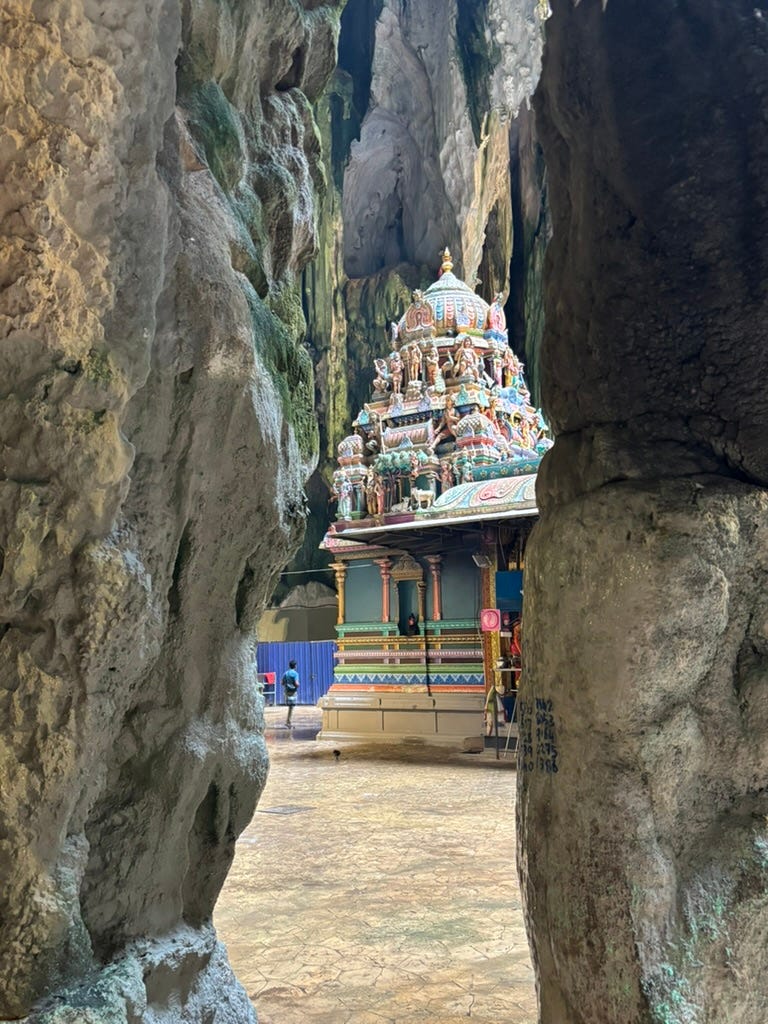I was in Kuala Lumpur before Christmas for work and pleasure - I love Malaysia and don’t need many excuses to visit. I’ve been paying close attention to the semi-conductor industry for a while; with Trump’s election, I’m following it even more closely (and will write about this on Substack in the coming weeks and months).
While in KL, I went to the Batu caves, a series of caverns carved into limestone rock a few kilometres from the city centre. The caves are home to several Hindu temples, the most famous (and popular) of which is dedicated to Murugan, the god of war.
They are a popular pilgrimage place, especially for Tamil populations in Malaysia and Southeast Asia, as well as from further afield. In 2023, more than 1.5m people visited during the Thaipusam festival (a Tamil Hindu festival celebrated on the first full moon day of the Tamil month) that took place in February; earlier this year, 2m were expected to visit when it took place.
The caves were not made in antiquity or the middle ages (both times of extensive contacts between South and Southeast Asia); in fact, the first Hindu temple was only constructed in the 1890s.
My father was a geologist, and always encouraged me to pay attention to rock formations. So I love a good limestone formation and these get changed by nature. Rain and water help hollow out caves (I’ll post about cenotes in Central America in due course); in this case, caves that formed through rock weathering became home to thousands of bats.
Bats do lots of things - including harbouring a host of pathogens that are dangerous to other mammals (including humans). But they also do what all animals do: produce a lot of droppings/excrement/poo/shit. In fact, large bats populations can produce copious amounts of faecal droppings at reported rates of up to 10 cm per year.
Most people stay well away from shit - though in recent vernacular, it has had a renaissance and can be a positive thing. Hence lyrics like:
I'm the shit with no makeup, don't have to curl my hair up
All this booty here mine, I'm a dollar worth a dime
Real bosses stand up, ladies throw your hands up and say
"I know I'm cute, I know I'm fly
You ask me why? 'Cause I'm the shit!"
Without giving Nicky Minaj too much credit, I suspect one reason why ‘shit’ has an ambivalent meaning is because of the miraculous powers that it has as a fertiliser.
In fact, the value of excrement explains why the Batu caves became so important and well-known in the late 19th century. Vast amounts of droppings were discovered there in the 1860s and dug out by Chinese workers brought as labour by the British - who found the Malay peninsula a prodigious source of tin (and in the early 20th century, a pre-eminent source of rubber).
While ‘batshit’ is often used pejoratively, it has extraordinary powers as a fertiliser - just like bird droppings. The Batu caves, then, become prominent in an age of agricultural and ecological revolutions, when demand for fertiliser soared. Not all of this was batshit; birdshit was highly prized too - including in Andean societies long before the arrival of Europeans.
To give some perspective, guano (the Quechua word for ‘shit’) not only became one of the most important exports from Latin America in the mid-19th century, but a cause for the expanion of the interests of the United States. The Guano Act, passed by Congress in 1856 gave US citizens the right to claim and occupy lands around the world. As the pre-amble declares:
‘Whenever any citizen of the United States discovers a deposit of guano on any island, rock, or key, not within the lawful jurisdiction of any other government, and not occupied by the citizens of any other government, and takes peaceable possession thereof, and occupies the same, such island, rock, or key may, at the discretion of the President, be considered as appertaining to the United States.’
Several of these islands are still in US hands, including the Midway Atoll, famous first as a staging post for telegraph communication and flights between the United States and Asia and then as the location of the battle on which many historians argue the Second World War in the Pacific turned.
Guano, then, was the oil of the mid-19th century - the source of wealth, as well as of geopolitical tension. Indeed, competiton for guano was so intense that it underpinned the biggest war in South American history - the War of the Pacific (1879–84), which pitted Peru and Bolivia against Chile. The success of the latter, which included seizing the lion’s share of Peru’s guano deposits, redrew the map of South America, depriving Bolivia of a Pacific coastline (leading to still current territorial claims) and bankrupting Peru.
The Batu caves did not do the same thing - partly because business interests in Southeast Asia were sewn up more successfully by private capital. But the wealth they produced made them locally famous, and an ideal place for K. Thamboosamy Pillay (1850-1902), a prominent member of the business community, to help fund a new temple.
They are still there today, notable as one of Malaysia’s most visited tourist attractions. The caves serve as a neat combination of natural, mineral and financial wealth. And perhaps if one is generous, also a good story about adaptation: although the gauno extractors are long gone, the fact that the site now attracts pilgrims tells its own story about how versatile humans can be in transforming the world around them.






Thanks for sharing. Aside from the guano wars and the ecological value, there are quite a few cultures that attach value to bat shit. Crazy.